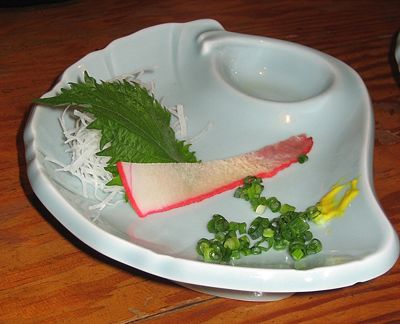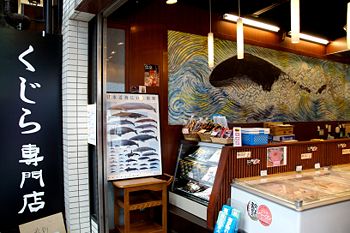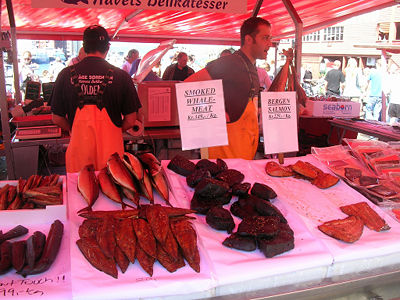Whale meat: Difference between revisions
imported>John Stephenson (Start) |
imported>John Stephenson (delete irrelevant and unsubstantiated comment; slight rewrite elsewhere) |
||
| Line 3: | Line 3: | ||
'''Whale meat''' refers to the edible flesh of various [[species]] of [[whale]]. It can be prepared and eaten in various ways, and for example forms one part of traditional [[Japan]]ese cuisine (鯨肉 ''gei niku'' 'whale meat'). Whales are also [[hunting|hunted]] for their [[meat]] by [[Norway]] and some [[Aboriginal]] communities, and so servings will most likely appear on menus in those countries. | '''Whale meat''' refers to the edible flesh of various [[species]] of [[whale]]. It can be prepared and eaten in various ways, and for example forms one part of traditional [[Japan]]ese cuisine (鯨肉 ''gei niku'' 'whale meat'). Whales are also [[hunting|hunted]] for their [[meat]] by [[Norway]] and some [[Aboriginal]] communities, and so servings will most likely appear on menus in those countries. | ||
In recent years, however, concerns have been raised about the levels of [[pollution|pollutants]] in samples of whale meat,<ref>''[[New Scientist]]'': '[http://www.newscientist.com/article/dn2362-extreme-mercury-levels-revealed-in-whalemeat-.html Extreme mercury levels revealed in whalemeat]'. 6th June 2002.</ref> and many people around the world object to the hunting and eating of whales | In recent years, however, concerns have been raised about the levels of [[pollution|pollutants]] in samples of whale meat,<ref>''[[New Scientist]]'': '[http://www.newscientist.com/article/dn2362-extreme-mercury-levels-revealed-in-whalemeat-.html Extreme mercury levels revealed in whalemeat]'. 6th June 2002.</ref> and many people around the world object to the hunting and eating of whales and [[dolphin]]s. | ||
==Whale meat in Japan== | ==Whale meat in Japan== | ||
| Line 9: | Line 9: | ||
Whale meat is considered a delicacy in Japan. It is readily available from specialist shops (signed 鯨 or くじら ''kujira'', 'whale') , and is often chopped into small slices to make ''[[sashimi]]'' (刺身) - thin strips of raw meat or other [[seafood]]. Different regions prepare the meat in distinct ways; for example, whale meat in [[Kyushu]] is served as fresh as possible, whereas northern diners prefer the meat to be flavoured through delaying freezing for a day or so after slaughter.<ref>''[[BBC]] News'': '[http://news.bbc.co.uk/2/hi/asia-pacific/7281989.stm Why Japan persists in hunting whales]'. 7th March 2008.</ref> | Whale meat is considered a delicacy in Japan. It is readily available from specialist shops (signed 鯨 or くじら ''kujira'', 'whale') , and is often chopped into small slices to make ''[[sashimi]]'' (刺身) - thin strips of raw meat or other [[seafood]]. Different regions prepare the meat in distinct ways; for example, whale meat in [[Kyushu]] is served as fresh as possible, whereas northern diners prefer the meat to be flavoured through delaying freezing for a day or so after slaughter.<ref>''[[BBC]] News'': '[http://news.bbc.co.uk/2/hi/asia-pacific/7281989.stm Why Japan persists in hunting whales]'. 7th March 2008.</ref> | ||
The Japanese have hunted whales since at least the eighth century, since the practice is mentioned in the ''Kojiki'' (古事記), Japan's oldest document, dating back to that time.<ref>''Beijing Review'': '[http://www.bjreview.com.cn/world/txt/2007-12/28/content_93184.htm A Whale of A Controversy]'. 28th December 2007.</ref><ref>''Japan Whaling Association'': '[http://www.whaling.jp/english/isana/no27_01.html Enjoying the Etymology of Whales]'. ''ISANA'' newsletter 27, July 2003.</ref><ref>''Japan Times'': '[http://search.japantimes.co.jp/cgi-bin/rc20080203a5.html Whaling dates back centuries]'. Letter to the editor, 3rd February 2008.</ref> Whale meat was common in the nation's diet until the mid-twentieth century. In recent years, the government of Japan has encouraged people to eat more whale meat, as sales have been declining. School programmes have been set up to educate children on the life cycle of the meat, from the ocean to the dinner plate. Adult courses | The Japanese have hunted whales since at least the eighth century, since the practice is mentioned in the ''Kojiki'' (古事記), Japan's oldest document, dating back to that time.<ref>''Beijing Review'': '[http://www.bjreview.com.cn/world/txt/2007-12/28/content_93184.htm A Whale of A Controversy]'. 28th December 2007.</ref><ref>''Japan Whaling Association'': '[http://www.whaling.jp/english/isana/no27_01.html Enjoying the Etymology of Whales]'. ''ISANA'' newsletter 27, July 2003.</ref><ref>''Japan Times'': '[http://search.japantimes.co.jp/cgi-bin/rc20080203a5.html Whaling dates back centuries]'. Letter to the editor, 3rd February 2008.</ref> Whale meat was common in the nation's diet until the mid-twentieth century. In recent years, the government of Japan has encouraged people to eat more whale meat, as sales have been declining. School programmes have been set up to educate children on the life cycle of the meat, from the ocean to the dinner plate. Adult courses in preparing whale meat have also appeared. Total sponsorship by the government runs into millions of dollars annually.<ref>''[[Washington Post]]'': '[http://www.washingtonpost.com/wp-dyn/content/article/2005/06/18/AR2005061800890.html Reviving a Taste for Whale]'. 7th March 2008.</ref> | ||
Revision as of 00:18, 7 March 2008
Whale meat refers to the edible flesh of various species of whale. It can be prepared and eaten in various ways, and for example forms one part of traditional Japanese cuisine (鯨肉 gei niku 'whale meat'). Whales are also hunted for their meat by Norway and some Aboriginal communities, and so servings will most likely appear on menus in those countries.
In recent years, however, concerns have been raised about the levels of pollutants in samples of whale meat,[1] and many people around the world object to the hunting and eating of whales and dolphins.
Whale meat in Japan
Whale meat is considered a delicacy in Japan. It is readily available from specialist shops (signed 鯨 or くじら kujira, 'whale') , and is often chopped into small slices to make sashimi (刺身) - thin strips of raw meat or other seafood. Different regions prepare the meat in distinct ways; for example, whale meat in Kyushu is served as fresh as possible, whereas northern diners prefer the meat to be flavoured through delaying freezing for a day or so after slaughter.[2]
The Japanese have hunted whales since at least the eighth century, since the practice is mentioned in the Kojiki (古事記), Japan's oldest document, dating back to that time.[3][4][5] Whale meat was common in the nation's diet until the mid-twentieth century. In recent years, the government of Japan has encouraged people to eat more whale meat, as sales have been declining. School programmes have been set up to educate children on the life cycle of the meat, from the ocean to the dinner plate. Adult courses in preparing whale meat have also appeared. Total sponsorship by the government runs into millions of dollars annually.[6]
Whale meat in Norway
Norwegian markets supply whale meat, usually from minke whales, in cities such as Bergen. Often the meat is smoked, but fresh whale meat is also available. English signs are often placed to help buyers unfamiliar with Norwegian to identify the meat amongst other produce. Whereas the Japanese usually consume whale meat in small amounts, as a delicacy, Norwegians prefer whale steaks, sometimes seasoned with parsley or red and green peppers.[7]
Footnotes
- ↑ New Scientist: 'Extreme mercury levels revealed in whalemeat'. 6th June 2002.
- ↑ BBC News: 'Why Japan persists in hunting whales'. 7th March 2008.
- ↑ Beijing Review: 'A Whale of A Controversy'. 28th December 2007.
- ↑ Japan Whaling Association: 'Enjoying the Etymology of Whales'. ISANA newsletter 27, July 2003.
- ↑ Japan Times: 'Whaling dates back centuries'. Letter to the editor, 3rd February 2008.
- ↑ Washington Post: 'Reviving a Taste for Whale'. 7th March 2008.
- ↑ For two recipes, see highnorth.no: 'Norwegian Whale Meat Recipes'.


